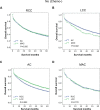The effects of chemotherapy, primary tumor location and histological subtype on the survival of stage III colon cancer patients
- PMID: 37020295
- PMCID: PMC10077613
- DOI: 10.1186/s12876-023-02741-3
The effects of chemotherapy, primary tumor location and histological subtype on the survival of stage III colon cancer patients
Abstract
Objective: Colon cancer (CC) is one of the most common cancers worldwide and has a poor prognosis. Surgery followed by adjuvant chemotherapy is the standard treatment strategy for stage III CC patients. Primary tumor location (PTL) is an important factor for the long-term survival of CC. However, the difference in the prognosis between the histological subtypes of mucinous adenocarcinoma (MAC) and nonspecific adenocarcinoma (AC) in stage III CC patients is unclear. The correlation of chemotherapy, PTL and histological subtype with the overall survival (OS) of stage III CC patients has not yet been explored.
Methods: Patients diagnosed with stage III CC from 2010 to 2016 in the Surveillance, Epidemiology, and End Results (SEER) database were retrieved. The clinicopathological features and OS were analyzed according to the chemotherapy, PTL and histological subtype.
Results: A total of 28,765 eligible stage III CC patients were enrolled in this study. The results showed that chemotherapy, left-sided CC (LCC) and AC were favorable prognostic factors for OS. Right-sided CC (RCC) had worse OS than LCC regardless of chemotherapy. MAC had worse OS than AC in the patients with chemotherapy, but the survival benefits disappeared in the patients without chemotherapy. Additionally, in LCC, MAC had worse OS than AC regardless of chemotherapy. However, in RCC, MAC had worse OS than AC in patients with chemotherapy but had similar OS to AC in patients without chemotherapy. In the AC group, RCC had worse OS than LCC regardless of chemotherapy. In the MAC group, RCC had comparable OS to LCC regardless of chemotherapy. Four subgroups, i.e., RCC/MAC, RCC/AC, LCC/MAC and LCC/AC, all showed benefits from chemotherapy. Among them, LCC/AC had the best OS, and RCC/MAC had the worst OS compared with the other three subgroups.
Conclusion: The prognosis of MAC is worse than that of AC in stage III CC. LCC/AC has the best OS, while RCC/MAC has the worst OS but still benefits from chemotherapy. The impact of chemotherapy on survival is greater than that of histological subtype, but the impact of histological subtype on survival is similar to that of PTL.
Keywords: Chemotherapy; Colon cancer; Mucinous adenocarcinoma; Overall survival; Primary tumor location.
© 2023. The Author(s).
Conflict of interest statement
The authors declare no competing interests.
Figures







Similar articles
-
Prognostic value of primary tumor location in colorectal cancer: an updated meta-analysis.Clin Exp Med. 2023 Dec;23(8):4369-4383. doi: 10.1007/s10238-023-01120-2. Epub 2023 Jul 5. Clin Exp Med. 2023. PMID: 37405571 Review.
-
Survival Trends of Right- and Left-Sided Colon Cancer across Four Decades: A Norwegian Population-Based Study.Cancer Epidemiol Biomarkers Prev. 2022 Feb;31(2):342-351. doi: 10.1158/1055-9965.EPI-21-0555. Epub 2021 Dec 1. Cancer Epidemiol Biomarkers Prev. 2022. PMID: 34853022 Free PMC article.
-
Hemicolectomy Does Not Provide Survival Benefit for Right-Sided Mucinous Colon Adenocarcinoma.Front Oncol. 2021 Feb 1;10:608836. doi: 10.3389/fonc.2020.608836. eCollection 2020. Front Oncol. 2021. PMID: 33598431 Free PMC article.
-
Right- and left-sided stage III colon cancers present different prognostic outcomes of oxaliplatin-based adjuvant chemotherapy after curative resection.Cancer Manag Res. 2018 Jul 17;10:2095-2103. doi: 10.2147/CMAR.S163520. eCollection 2018. Cancer Manag Res. 2018. PMID: 30140160 Free PMC article.
-
Different treatment strategies and molecular features between right-sided and left-sided colon cancers.World J Gastroenterol. 2015 Jun 7;21(21):6470-8. doi: 10.3748/wjg.v21.i21.6470. World J Gastroenterol. 2015. PMID: 26074686 Free PMC article. Review.
Cited by
-
Clinicopathological characteristics and outcomes of colorectal mucinous adenocarcinoma: a retrospective analysis from China.Front Oncol. 2024 Feb 6;14:1335678. doi: 10.3389/fonc.2024.1335678. eCollection 2024. Front Oncol. 2024. PMID: 38380362 Free PMC article.
-
Constructing a nomogram to predict overall survival of colon cancer based on computed tomography characteristics and clinicopathological factors.World J Gastrointest Oncol. 2024 Oct 15;16(10):4104-4114. doi: 10.4251/wjgo.v16.i10.4104. World J Gastrointest Oncol. 2024. PMID: 39473950 Free PMC article.
References
-
- Benson AB, 3rd, Venook AP, Bekaii-Saab T, Chan E, Chen YJ, Cooper HS, Engstrom PF, Enzinger PC, Fenton MJ, Fuchs CS, et al. Colon cancer, version 3.2014. J Natl Compr Canc Netw. 2014;12(7):1028–59. - PubMed
MeSH terms
Grants and funding
LinkOut - more resources
Full Text Sources
Medical

